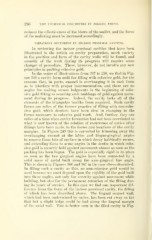Page 594 - My FlipBook
P. 594
286 THE TECHNICAL PROCEDUBES IX FILLING TEETH.
reduces the effectiveness of the blows of the mallet, and the force
of the malleting must be increased accordingly.
VARIATIONS OCCURRING IN INCISOR PROXIMAL CAVITIES.
In reviewing the incisor proximal cavities that have been
illustrated in the article on cavity preparation, much variety
in the position and form of the cavity walls will be found, and
security of the work during its progress will require some
changes of procedure. These, however, do not involve any new
principles in packing cohesive gold.
In the series of illustrations from 247 to 250, we find in Fig-
ure 248 a cavity form unfit for filling with cohesive gold, for the
reasons that, in parts, enamel is overhanging it in such form
as to interfere with proper instrumentation, and there are no
angles for making secure lodgments in the beginning of cohe-
sive gold filling or securing such buildings of gold against move-
ment during its progress. Indeed, the cavity lacks all of the
elements of the triangular boxlike form required. Such cavity
forms are relics of the former practice of filling with non-cohe-
sive gold, which dentists have been slow in changing to the
forms necessary to cohesive gold work. And, further, they are
relics of a time when cavity formation had not been correlated to
what is now known of the relation of recurrence of caries after
fillings have been made, to the forms and locations of the cavity
margins. In Figure 249 this is corrected by trimming away the
overhanging enamel at the labio- and linguo-gingival angles
to remove those bits of surface in which decay habitually recurs,
and extending these to acute angles in the dentin in which cohe-
sive gold is securely held against movement almost as soon as the
packing has been begun. The gold is especiallj' rigid in its place
so soon as the two gingival angles have been connected by a
solid mass of metal built along the axio-gingival line angle.
This is shown in Figures 366 and 367 in the case above described.
In filling such a cavity as this, no non-cohesive gold would be
used because we must depend upon the rigidity of the gold built
into these angles, not only for security against movement while
building, but also for the permanent retention of the filling dur-
ing its years of service. In this case we find one important dif-
ference from the form of the incisor proximal cavity, the filling
of which has been described above. The lingual enamel wall,
which had been undermined by caries, has been cut away so far
that but a slight ledge could be had along the lingual margin
of the axial wall. This is better seen in the filled cavity in Fig-


